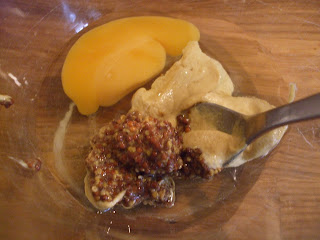Ah Sunday lunch. An glorious institution and a time of the week where the basting of meat and the fluffing of parboiled potatoes for 'roasties' is the done thing. A roast dinner isn't necessarily an arduous task but I was looking for something a little quicker this weekend for I fancied an early dinner so I could sit myself in front of the TV and watch the football, so this oft done recipe chez Lola and Finn fitted the bill exactly. I prepped the meat before and put it in the oven around the time the roast potatoes were half done, whipped up the sauce and by the time everything was ready the house was filled with wondrous garlic gorgeousness. Yum.
I didn't realise this recipe was a Delia, for I had cut the recipe out of a magazine years ago and had it stuck in a file. It was only by a bit of curious googling that I found its source. I have to say I am not surprised, because it is completely delish. An initial faff, yes, but easy to prep ahead of time to be covered and put in the fridge until you need it. It's also a use for that mustard I brought back from France that I haven't got round to using up yet. I really must avoid impulse buying.
The changes I made here were subtle. I subbed shallots in the sauce as I like their more delicate flavour. I also liven it up a touch at the end with a squeeze of lemon but you need to taste the finished sauce yourself to decide whether it needs it. I also upped the quantity of parsley and garlic slightly in the breadcrumb mix because I find it makes the coating a little more dense and moist, and therefore sticks to the pork loin better.
Lastly, pork loin needs a bit of tender living care because it can dry out, it being such a lean cut. It does need to be ever so slightly pink in my opinion and well rested so it does not resemble the texture of an old boot, though the sauce helps enormously should that happen. Plenty of sauce and no one will ever know!
Roast Pork Loin with Creme Fraiche and Mustard sauce, adapted from Delia Smith (recipe from Delia Online)
Serves 2, plus Lola and Finn
Ingredients:
| 1 pork tenderloin |
| 1 egg |
| 1 dessertspoon wholegrain mustard |
| 1 dessertspoon Dijon mustard |
| 2 cloves garlic, peeled |
| A handful of flat leaf parsley |
| 2 heaped tablespoons natural breadcrumbs (from a packet) though I blitzed a stale slice of bread |
| salt and freshly milled black pepper |
| For the sauce: |
| 1 heaped teaspoon wholegrain mustard |
| 1 heaped teaspoon Dijon mustard |
| 1 tablespoon crème fraîche |
| ½ oz (10 g) butter |
| 3 shallots, finely chopped |
| 150ml dry white wine salt and pepper to taste a squeeze of lemon (optional) |
| Method: |
Preheat the oven to 190c/375f if you are cooking this straight after preparation.
Trim any excess fat and sinew from the pork tenderloins. Find a dish that will fit the loin in comfortably, though I cut my loin in half when I found that a difficulty.
In a small bowl, beat the ingredients needed to coat the loin, that is the egg together with the mustards.
Next, chop the garlic and parsley (in a mini-chopper or processor, if you have one), add the breadcrumbs and a seasoning of salt and pepper, then whizz for a couple of seconds.
At this point you could use the method whereby you have separate dishes to coat the loins as in, a dish of the egg mixture, then a dish of the breadcrumbs. I find that a bit of a faff so I just brushed the egg mixture on with a silicon brush and then pressed the breadcrumbs on after that in the dish that the loin will be cooked in. Each to their own.
At this point you can cover the loin in their dish or tray and put in the fridge until required, remembering to bring the meat back up to room temperature before you place it in the oven.
After you have coated the loin and put them on a greased tray or dish, roast the fillets in the pre-heated oven for about 30 minutes for meat that is slightly pink. You may wish to cook it for longer. Meanwhile, make the sauce. Heat the butter in a small saucepan and cook the shallots in it on a medium heat for about 10 minutes until softened. Add the white wine, turn up the heat and boil for 10 minutes to reduce slightly, before adding the crème fraîche and mustards, then simmer gently for a further 10 minutes. You should taste at this point to test for seasoning. I often add a bit more creme fraiche to make it more creamy for Lola and Finn. When the pork is cooked, let it rest in a warm place for about 10 minutes before carving into slices and serving with the sauce.
We had roasties, carrots and broccoli, and it was a perfectly suitable alternative to roast beef and Yorkshire pudding. Well, nearly.
|



















































